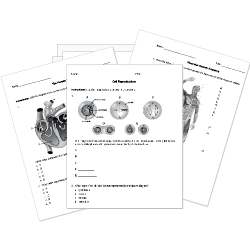| __ |
A type of protein molecule found in the chromosomes of eukaryotic cells but not prokaryotic cells
|
A. |
Growth Factor |
| __ |
One of the two strands of a chromosome that become visible during meiosis or mitosis
|
B. |
Centromere |
| __ |
The region of the chromosomes that holds the two sister chromatids together during mitosis
|
C. |
Prophase |
| __ |
First phase of mitosis when chromatin condenses, the nuclear envelope breaks down, the nucleolus disappears, and the centrosomes and centrioles migrate to opposite sides of the cell;
|
D. |
Anaphase |
| __ |
Second phase of mitosis when spindle fibers align in the chromosome along the cell equator
|
E. |
Malignant |
| __ |
Third phase of mitosis during which chromatids separate and are pulled to opposite sides of the cell
|
F. |
Cell Cycle |
| __ |
Last phase of mitosis when a complete set of identical chromosomes is positioned at each pole of the cell, the nuclear membranes start to form, the chromosomes begin to uncoil, and the spindle fibers disassemble
|
G. |
Benign |
| __ |
Pattern of growth, DNA replication, and cell division that occurs in a eukaryotic cell
|
H. |
Telophase |
| __ |
In eukaryotic cells, a process of cell division that forms two new nuclei, each of which has the same number of chromosomes
|
I. |
Apoptosis |
| __ |
Broad group of proteins that stimulate cell division
|
J. |
Mitosis |
| __ |
Programmed cell death
|
K. |
Cancer |
| __ |
Common name for a class of diseases characterized by uncontrolled cell division
|
L. |
Histone |
| __ |
Having no dangerous effect on health, especially referring to an abnormal growth of cells that are not cancerous
|
M. |
Metaphase |
| __ |
Cancerous tumor in which cells break away and spread to other parts of the body, causing harm to the organism’s health
|
N. |
Chromatid |






